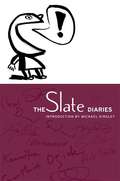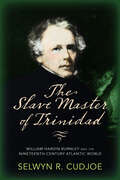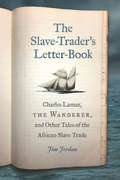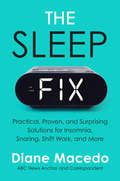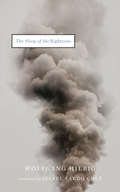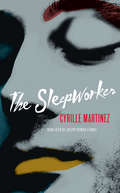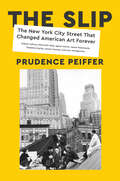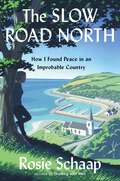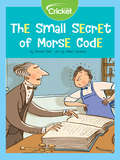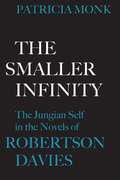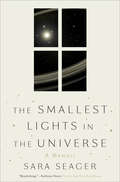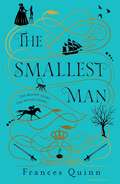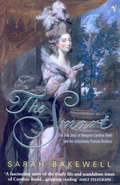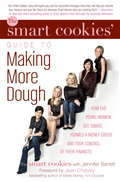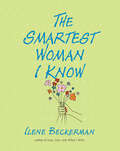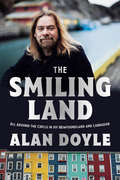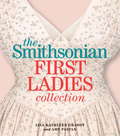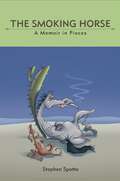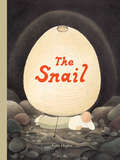- Table View
- List View
The Slate Diaries
by Judith Shulevitz Jodi Kantor Cyrus KroneEach week the editors of Slate, one of the on-line literary magazines, ask a different person to keep a diary. The Slate Diaries is a selection of some of the best of those diaries. Contributors include distinguished writers.
The Slave Master of Trinidad: William Hardin Burnley and the Nineteenth-Century Atlantic World
by Selwyn R. CudjoeWilliam Hardin Burnley (1780–1850) was the largest slave owner in Trinidad during the nineteenth century. Born in the United States to English parents, he settled on the island in 1802 and became one of its most influential citizens and a prominent agent of the British Empire. A central figure among elite and moneyed transnational slave owners, Burnley moved easily through the Atlantic world of the Caribbean, the United States, Great Britain, and Europe, and counted among his friends Alexis de Tocqueville, British politician Joseph Hume, and prime minister William Gladstone. In this first full-length biography of Burnley, Selwyn R. Cudjoe chronicles the life of Trinidad's "founding father" and sketches the social and cultural milieu in which he lived. Reexamining the decades of transition from slavery to freedom through the lens of Burnley's life, The Slave Master of Trinidad demonstrates that the legacies of slavery persisted in the new post-emancipation society.
The Slave-Trader's Letter-Book: Charles Lamar, The Wanderer, and Other Tales of the African Slave Trade (UnCivil Wars)
by Jim JordanLong-lost letters tell the story of an illegal slave shipment, a desperate Savannah businessman, and the lead-up to the Civil War. In 1858 Savannah businessman Charles Lamar, in violation of U.S. law, organized the shipment of hundreds of Africans on the luxury yacht Wanderer to Jekyll Island, Georgia. The four hundred survivors of the Middle Passage were sold into bondage. This was the first successful documented slave landing in the United States in about four decades, and it shocked a nation already on the path to civil war. Nearly thirty years later, the North American Review published excerpts from thirty of Lamar&’s letters, reportedly taken from his letter book, which describe his criminal activities. However, the authenticity of the letters was in doubt until very recently. In the twenty-first century, researcher Jim Jordan found a cache of private papers belonging to Charles Lamar&’s father, stored for decades in an attic in New Jersey. Among the documents was Charles Lamar&’s letter book—confirming him as the author. The first part of this book recounts the flamboyant and reckless life of Lamar himself, including involvement in southern secession, the slave trade, and a plot to overthrow the government of Cuba. A portrait emerges at odds with Lamar's previous image as a savvy entrepreneur and principled rebel. Instead, we see a man who was often broke and whose volatility sabotaged him at every turn. His involvement in the slave trade was driven more by financial desperation than southern defiance. The second part presents the &“Slave-Trader's Letter-Book.&” Together with annotations, these seventy long-lost letters shed light on the lead-up to the Civil War from the remarkable perspective of a troubled, and troubling, figure.
The Sleep Fix: Practical, Proven, and Surprising Solutions for Insomnia, Snoring, Shift Work, and More
by Diane MacedoFrom renowned ABC News anchor/correspondent and former insomniac Diane Macedo, comes a practical, user-friendly guide to getting better sleep. The Sleep Fix flips the switch on common advice, illuminating the reporter’s relentless search for how to get a good night’s sleep and the surprising, scientific, and practical solutions she found along the way. Roughly thirty percent of the population is estimated to be living with insomnia, while many more unknowingly suffer from other sleep disorders. In The Sleep Fix, Macedo aims to change that with perspective-shifting research and easy-to-implement solutions based not just on science and experts, but also her own years-long struggle. As an early-morning reporter and overnight news anchor, Macedo learned the hard way how valuable sleep is, and how it affects everything from our heart to our brain to our immune system. The longer Macedo struggled, the more her health deteriorated. Desperate, she tried standard sleep tip after standard sleep tip, but nothing worked - instead, it made her worse. Finally, after developing a tolerance to sleeping pills, Macedo decided to attack the problem as a journalist, interviewing sleep experts from all over the world to get to the bottom of what really keeps us from sleeping—and the various ways to fix it. As Macedo explains, the solution to catching zzz’s isn’t as simple as giving up caffeine, or putting away your phone before bed. With her down-to-earth explanations and humor, she instead teaches us how to: • Understand sleep biology• Identify sleep obstacles• Flag sleep myths and separate fact from fiction• Try counterintuitive approaches• Shift our mindset Most importantly, Macedo — a busy, working mom — teaches us how to adjust and fit these solutions into our everyday lives. Offering expert wisdom, cutting-edge research, intimate sleep stories from public figures, and actionable advice, The Sleep Fix is the tell-it-like-it-is guide this sleep-deprived world has been waiting for.
The Sleep Of The Righteous
by László Krasznahorkai Wolfgang Hilbig Isabel Fargo ColeDoppelgängers, a murderer’s guilt, pulp noir, fanatical police, and impossible romances--these are the pieces from which German master Wolfgang Hilbig builds a divided nation battling its demons. Delving deep into the psyches of both East and West Germany, The Sleep of the Righteous reveals a powerful, apocalyptic account of the century-defining nation’s trajectory from 1945 to 1989. From a youth in a war-scarred industrial town to wearying labor as a factory stoker, surreal confrontations with the Stasi, and, finally, a conflicted escape to the West, Hilbig creates a cipher that is at once himself and so many of his fellow Germans. Evoking the eerie bleakness of films like Tarkovsky’s Stalker and The Lives of Others, this titan of German letters combines the Romanticism of Poe with the absurdity of Kafka to create a visionary, somber statement on the ravages of history and the promises of the future.
The Sleepworker
by Cyrille Martinez Joseph Patrick Stancil"As New York, capital of the twentieth century, recedes from memory, it becomes more like Paris; we flock to it to pay tribute to the great things that once happened there. New York is now a miasma of apocryphal myths feasting on its own corpse. On these pages, Martinez spins hazy rumor and wilting gossip into blistering contemporary fiction, holding up Warhol's mirror to the myth of Warhol himself. The result is a delicious celebration of simulacra where, like New York New York itself, nothing is true, but everything is permitted."--Kenneth GoldsmithJohn is a poet. Only John almost never writes poems, because he is also unemployed. He lives with four friends, and they squat in a loft in New York New York, a fantastical city that resembles the Big Apple, but also any other city where artists live. They throw fabulous parties and practice group sodomy. That is, until John meets Andy.Andy is an artist. Well, he is if you define art as something that people don't want but the artist wants to give them anyway. A gallery owner with Tourette syndrome "discovers" his work and Andy is on his way to being famous. John, on the other hand, is hard at work at being unemployed, drinking all night and sleeping all day--which leaves him very little time for writing poems. Andy, watching him sleep, has an intriguing idea for a piece of art that he thinks will allow John to get paid for what he does best.Using the story of Andy Warhol and John Giorno and their film Sleep as a starting point, The Sleepworker reads like a Warhol film on fast-forward.Cyrille Martinez is a poet and novelist living in Paris. This is his English debut.Joseph Patrick Stancil has studied French and translation at UNC-Chapel Hill and New York University. He currently lives in New York, New York.
The Slip: The New York City Street That Changed American Art Forever
by Prudence PeifferLonglisted for the National Book Award · Shortlisted for the Apollo Book of the Year Award · A New York Times Notable Book of the YearThe never-before-told story of an obscure little street at the lower tip of Manhattan and the remarkable artists who got their start there. For just over a decade, from 1956 to 1967, a collection of dilapidated former sail-making warehouses clustered at the lower tip of Manhattan became the quiet epicenter of the art world. Coenties Slip, a dead-end street near the water, was home to a circle of wildly talented and varied artists that included Robert Indiana, Ellsworth Kelly, Agnes Martin, James Rosenquist, Delphine Seyrig, Lenore Tawney, and Jack Youngerman. As friends and inspirations to one another, they created a unique community for unbridled creative expression and experimentation, and the works they made at the Slip would go on to change the course of American art.Now, for the first time, Prudence Peiffer pays homage to these artists and the unsung impact their work had on the direction of late twentieth-century art and film. This remarkable biography, as transformative as the artists it illuminates, questions the very concept of a “group” or “movement,” as it spotlights the Slip’s eclectic mix of gender and sexual orientation, abstraction and Pop, experimental film, painting, and sculpture, assemblage and textile works. Brought together not by the tenets of composition or technique, nor by philosophy or politics, the artists cultivated a scene at the Slip defined by a singular spirit of community and place. They drew lasting inspiration from one another, but perhaps even more from where they called home, and the need to preserve the solitude its geography fostered. Despite Coenties Slip’s obscurity, the entire history of Manhattan was inscribed into its cobblestones—one of the first streets and central markets of the new colony, built by enslaved people, with revolutionary meetings at the tavern just down Pearl Street; named by Herman Melville in Moby Dick and site of the boom and bust of the city’s maritime industry; and, in the artists’s own time, a development battleground for Jane Jacobs and Robert Moses. The Slip’s history is entwined with that of the artists and their art—eclectic and varied work that was made from the wreckage of the city’s many former lives.An ambitious and singular account of a time, a place, and a group of extraordinary people, The Slip investigates the importance of community, and makes an argument for how we are shaped by it, and how it in turns shapes our work.
The Slippery Year: A Meditation on Happily Ever After
by Melanie GideonHave you ever sat across the breakfast table from your husband and wondered, "How did I get here?" Do the things that once made you complete-including your husband-now feel like a burden? Is the life you are leading an unrecognizable version of the one you imagined for yourself not so very long ago? Welcome to the world of Melanie Gideon. THE SLIPPERY YEAR chronicles a year in which Gideon confronts both the fantasies of her receding youth and the realities of midlife with a husband and a child and a dog (one of whom runs away). Marriage changes passion, Gideon confides; suddenly you're in bed with a relative (in Gideon's case, a relative with a penchant for buying residential vehicles online.) She reflects on the exigencies of family life-the need for a household catastrophe plan, the fainting spell occasioned by the departure of her nine year old son for camp. With wit, tenderness, and unsparing honesty, Gideon captures that moment in our lives when the magic starts to ebb, and when the things you have loved forever begin to fall away for the first time. It is the story of a woman's quest, in the face of all the big questions ("What's this loose skin around my knees? I don't look as old as she does, do I?") to reignite passion, beauty and mystery, and discover if 'happily ever after' is a possibility after all.
The Slow Road North: How I Found Peace in an Improbable Country
by Rosie SchaapFrom the acclaimed author of the “wonderfully funny and openhearted” (NPR) Drinking with Men comes a poignant, wrenching, and ultimately hopeful book—equal parts memoir and social history—that follows the author, after a series of tragic losses, to Northern Ireland, where she finds a path toward healing.Rosie Schaap had a solid career as a journalist and a life that looked to others like nonstop fun: all drinking and dining and traveling to beautiful places—and getting paid to write about it. But under the surface she was reeling from the loss of her husband and her mother—who died just one year apart. Caring for them had claimed much of her daily life in her late thirties. Mourning them would take longer.It wasn’t until a reporting trip took her to the Northern Irish countryside that Rosie found a partner to heal with: Glenarm, a quiet, seaside village in County Antrim. That first visit made such an impression she returned to make a life. This unlikely place—in a small, tough country mainly associated with sectarian strife—gave her a measure of peace that had seemed impossible elsewhere.Weaving personal narrative and social history, The Slow Road North is a moving and wise look at how a community can offer the key to healing. It’s a portrait of a complicated place at a pivotal time—through Brexit, a historic school integration, and a pandemic—and a love letter to a village and a culture.
The Small Secret of Morse Code
by Pamela DellWant to know about the dots and dashes of Morse code? Learn how Morse code came into being and became less time-consuming and more efficient.
The Smaller Infinity: The Jungian Self in the Novels of Robertson Davies (The Royal Society of Canada Special Publications)
by Patricia MonkThe concepts of the Jungian theory of personality have long held considerable interest for Robertson Davies, both outside his fiction and as the explicit subject of The Manticore. This interpretive study discusses Davies' use of Jungian psychology as both a structural and a thematic device and touches on related themes of illusion and the nature of reality.Drawing extensively on early reviews and articles, Monk sketches the background to Davies' preoccupation with psychology, revealing its influence on his early writings, including the effect of the Jungian concept of the persona on Shakespeare's Boy Actors and the ocncept of the shadow on the Samuel Marchbanks material. She also notes the introduction of the important themes of illusion, as a mask for reality, and ambivalence which are extended in the Salterton trilogy, Fifth Business, and The Manticore. Monk concludes that World of Wonders reveals an apparent but unsuccessful attempt on Davies' part to get away from Jungian psychology, and an exploration of alternative myths of human identity: the romance myth of the hero and the Spenglerian myth of the Magian soul.
The Smallest Lights in the Universe: A Memoir
by Sara SeagerCanadian MIT astrophysicist Sara Seager interweaves the story of her search for meaning and solace after losing her first husband to cancer, her unflagging search for an Earth-like exoplanet and her unexpected discovery of new love.Sara Seager has made it her life's work to peer into the spaces around stars--looking for exoplanets outside our solar system, hoping to find the one-in-a-billion world enough like ours to sustain life. But with the unexpected death of her husband, her life became an empty, lightless space. Suddenly, she was the single mother of two young boys, a widow at forty, clinging to three crumpled pages of instructions her husband had written for things like grocery shopping--things he had done while she did pioneering work as a planetary scientist at MIT. She became painfully conscious of her Asperger's, which before losing her husband had felt more like background noise. She felt, for the first time, alone in the universe.In this probing, invigoratingly honest memoir, Seager tells the story of how, as she stumblingly navigated the world of grief, she also kept looking for other worlds. She continues to develop groundbreaking projects, such as the Starshade, a sunflower-shaped instrument that, when launched into space, unfurls itself so as to block planet-obscuring starlight, and she takes solace in the alien beauty of exoplanets. At the same time, she discovers what feels every bit as wondrous: other people, reaching out across the space of her grief. Among them are the Widows of Concord, a group of women offering consolation and advice, and her beloved sons, Max and Alex. Most unexpected of all, there is another kind of one-in-a-billion match with an amateur astronomer. Equally attuned to the wonders of deep space and human connection, The Smallest Lights in the Universe is its own light in the dark.
The Smallest Lights in the Universe: A Memoir
by Sara SeagerIn this luminous memoir, an MIT astrophysicist must reinvent herself in the wake of tragedy and discovers the power of connection on this planet, even as she searches our galaxy for another Earth.Sara Seager has always been in love with the stars: so many lights in the sky, so much possibility. Now a pioneering planetary scientist, she searches for exoplanets—especially that distant, elusive world that sustains life. But with the unexpected death of Seager&’s husband, the purpose of her own life becomes hard for her to see. Suddenly, at forty, she is a widow and the single mother of two young boys. For the first time, she feels alone in the universe.As she struggles to navigate her life after loss, Seager takes solace in the alien beauty of exoplanets and the technical challenges of exploration. At the same time, she discovers earthbound connections that feel every bit as wondrous, when strangers and loved ones alike reach out to her across the space of her grief. Among them are the Widows of Concord, a group of women offering advice on everything from home maintenance to dating, and her beloved sons, Max and Alex. Most unexpected of all, there is another kind of one-in-a-billion match, not in the stars but here at home.Probing and invigoratingly honest, The Smallest Lights in the Universe is its own kind of light in the dark.
The Smallest Man: the most uplifting book of the year
by Frances Quinn&‘I want you to remember something, Nat. You&’re small on the outside. But inside you&’re as big as everyone else. You show people that and you won&’t go far wrong in life.&’ A compelling story perfect for fans of The Doll Factory, The Illumination of Ursula Flight and The Familiars. My name is Nat Davy. Perhaps you&’ve heard of me? There was a time when people up and down the land knew my name, though they only ever knew half the story. The year of 1625, it was, when a single shilling changed my life. That shilling got me taken off to London, where they hid me in a pie, of all things, so I could be given as a gift to the new queen of England. They called me the queen&’s dwarf, but I was more than that. I was her friend, when she had no one else, and later on, when the people of England turned against their king, it was me who saved her life. When they turned the world upside down, I was there, right at the heart of it, and this is my story. Inspired by a true story, and spanning two decades that changed England for ever, The Smallest Man is a heartwarming tale about being different, but not letting it hold you back. About being brave enough to take a chance, even if the odds aren&’t good. And about how, when everything else is falling apart, true friendship holds people together.Praise for The Smallest Man: &‘Nat Davy is so charming that I couldn't bear to put this book down. I loved it&’ Louise Hare &‘A perfect fusion of history and invention… Nat&’s wit and humour make the poignancy of his story all the more powerful&’ Beth Morrey 'What a page-turner! A timely tale celebrating courage, determination and friendship' Anita Frank &‘A perfectly formed masterpiece&’ C.S. Quinn &‘I loved this book - a fascinating tale of extraordinary accomplishment, and a story about how anything is possible and how love has always been a beacon of hope&’ Phillip Schofield 'I found myself rooting for the Smallest Man in England from the very first page' Sonia Velton &‘A beautiful, heartwarming tale, weaving history and fiction intricately and seamlessly… I loved this book&’ Louise Fein &‘This book took me on an epic journey with a character that will always have a special place in my heart&’ Emma Cooper &‘An engaging, compelling, thought-provoking story of a life less ordinary&’ Caroline Scott &‘A beguiling and well-written tale&’ Ellen Alpsten &‘I absolutely fell for the book&’s narrator: an ebullient character whose voice and world view I adored&’ Polly Crosby
The Smart
by Sarah BakewellThe Smart is a true drama of eighteenth-century life with a mercurial, mysterious heroine. Caroline is a young Irishwoman who runs off to marry a soldier, comes to London and slides into a glamorous life as a high-class prostitute, a great risk-taker, possessing a mesmerising appeal. In the early 1770s, she becomes involved with the intriguing Perreau twins, identical in looks but opposite in character, one a sober merchant, the other a raffish gambler. They begin forging bonds, living in increasing luxury until everything collapses like a house of cards - and forgery is a capital offence. A brilliantly researched and marvellously evocative history, The Smart is full of the life of London streets and shots through with enduring themes - sex, money, death and fame. It bridges the gap between aristocracy and underworld as eighteenth-century society is drawn into the most scandalous financial sting of the age.
The Smart Cookies' Guide to Making More Dough
by The Smart Cookies Jennifer BarrettThey were five dynamic young women: smart, successful - and secretly drowning in debt. Inspired by an episode of The Oprah Winfrey Show on personal finance, Andrea, Angela, Katie, Robyn, and Sandra formed a money club, together developing strategies for turning their finances around. Just one year later, they had dramatically improved their financial situations - and had made major developments in their careers, relationships, and life goals to boot. Their proven recipe for success has since been featured on The Oprah Winfrey Show and MSNBC, and in the New York Daily News. How did they do it? These five women - with varied careers in marketing, public relations, social work, and TV production - joined forces to create a fun, simple, effective strategy for achieving financial success, forming a money club, and supporting each other every step of the way. Now, in this extraordinary hands-on guide, the women, who dubbed themselves the Smart Cookies, share the secrets of their success. Weaving anecdotes from their own lives with practical how-to advice, the Smart Cookies offer strategies that cut across the financial spectrum, whether you're deeply in debt or just want to manage your money better. Tackling the unique financial challenges facing women today, they offer easy-to-follow advice on everything from creating a spending plan to boosting your income to starting your own money club.
The Smart Money
by Michael KonikA riveting inside look at the lucrative world of professional high-stakes sports betting by a journalist who lived a secret life as a key operative in the world's most successful sports gambling ring. When journalist Michael Konik landed an interview with Rick "Big Daddy" Matthews, the largest bet he'd placed on a sporting event was $200. Konik, an expert blackjack and poker player, was no stranger to Vegas. But Matthews was in a different league: the man was rumored to be the world's smartest sports bettor, the mastermind behind "the Brain Trust," a shadowy group of gamblers known for their expertise in beating the Vegas line. Konik had heard the word on the street -- that Matthews was a snake, a conniver who would do anything to gain an edge. But he was also brilliant, cunning, and charming. And when he asked Konik if he'd like to "make a little money" during the football season, the writer found himself seduced . . . So began Michael Konik's wild ride as an operative of the elite Brain Trust. In The Smart Money, Konik takes readers behind the veil of secrecy shrouding the most successful sports betting operation in America, bypassing the myths and the rumors, going all the way to its innermost sanctum. He reveals how they -- and he -- got rich by beating the Vegas lines and, ultimately, the multimillion-dollar offshore betting circuit. He details the excesses and the betrayals, the horse-trading and the paranoia, that are the perks and perils of a lifestyle in which staking inordinate sums of money on the outcome of a single event -- sometimes as much as $1 million on a football game -- is a normal part of doing business.
The Smart Money
by Michael KonikA riveting inside look at the lucrative world of professional high-stakes sports betting by a journalist who lived a secret life as a key operative in the world's most successful sports gambling ring. When journalist Michael Konik landed an interview with Rick "Big Daddy" Matthews, the largest bet he'd placed on a sporting event was $200. Konik, an expert blackjack and poker player, was no stranger to Vegas. But Matthews was in a different league: the man was rumored to be the world's smartest sports bettor, the mastermind behind "the Brain Trust," a shadowy group of gamblers known for their expertise in beating the Vegas line. Konik had heard the word on the street -- that Matthews was a snake, a conniver who would do anything to gain an edge. But he was also brilliant, cunning, and charming. And when he asked Konik if he'd like to "make a little money" during the football season, the writer found himself seduced . . . So began Michael Konik's wild ride as an operative of the elite Brain Trust. In The Smart Money, Konik takes readers behind the veil of secrecy shrouding the most successful sports betting operation in America, bypassing the myths and the rumors, going all the way to its innermost sanctum. He reveals how they -- and he -- got rich by beating the Vegas lines and, ultimately, the multimillion-dollar offshore betting circuit. He details the excesses and the betrayals, the horse-trading and the paranoia, that are the perks and perils of a lifestyle in which staking inordinate sums of money on the outcome of a single event -- sometimes as much as $1 million on a football game -- is a normal part of doing business.
The Smart Money: How the World's Best Sports Bettors Beat the Bookies out of Millions
by Michael KonikA riveting inside look at the lucrative world of professional high-stakes sports betting by a journalist who lived a secret life as a key operative in the world's most successful sports gambling ring. When journalist Michael Konik landed an interview with Rick "Big Daddy" Matthews, the largest bet he'd placed on a sporting event was $200. Konik, an expert blackjack and poker player, was no stranger to Vegas. But Matthews was in a different league: the man was rumored to be the world's smartest sports bettor, the mastermind behind "the Brain Trust," a shadowy group of gamblers known for their expertise in beating the Vegas line. Konik had heard the word on the street -- that Matthews was a snake, a conniver who would do anything to gain an edge. But he was also brilliant, cunning, and charming. And when he asked Konik if he'd like to "make a little money" during the football season, the writer found himself seduced . . . So began Michael Konik's wild ride as an operative of the elite Brain Trust. InThe Smart Money, Konik takes readers behind the veil of secrecy shrouding the most successful sports betting operation in America, bypassing the myths and the rumors, going all the way to its innermost sanctum. He reveals how they -- and he -- got rich by beating the Vegas lines and, ultimately, the multimillion-dollar offshore betting circuit. He details the excesses and the betrayals, the horse-trading and the paranoia, that are the perks and perils of a lifestyle in which staking inordinate sums of money on the outcome of a single event -- sometimes as much as $1 million on a football game -- is a normal part of doing business.
The Smartest Woman I Know
by Ilene BeckermanIlene Beckerman’s first book “illuminates the experience of an entire generation of women,” wrote the New York Times Book Review in a full page of praise for Love, Loss, and What I Wore. It became a bestseller and inspired the hit Off-Broadway play by the same name. Now, Gingy returns with her fifth illustrated treasure, The Smartest Woman I Know—a tribute to the insightful woman who raised her. It’s been said there’s nobody as smart as an old woman. That’s Gingy’s grandmother, Ettie, though she had no more than a third-grade education. She dispensed unforgettable wisdom to Gingy and her sister, Tootsie, as well as to the customers at her and (her husband) Mr. Goldberg’s stationery and magazine store, where customers ranged from Irish nannies to Sara Delano Roosevelt to Marlene Dietrich. Clever about life and love, food and men, Ettie had advice for everyone, and it didn’t hurt that she got some of her best ideas from talking things over with God, out loud. Known for bringing wit and emotion to issues that concern women, depth and poignancy to subjects as seemingly trivial as clothes, beauty, and bridesmaids, Gingy now magically brings the irrepressible Ettie Goldberg to life.
The Smiling Land: All Around the Circle in My Newfoundland and Labrador
by Alan DoyleFrom one of Canada's most beloved and celebrated Newfoundlanders comes a rollicking insider's guide to the province, told as only Alan Doyle can tell it.Few Canadian musicians are as synonymous with their home province as Alan Doyle is to his—and even fewer once worked as tour guides. In The Smiling Land, Alan reprises his tour-guiding role to welcome the rest of Canada to his home and take readers on an adventure: a freewheeling road trip through Newfoundland, its history, and its culture. From Fogo Island to the Southwest Coast, Labrador to Ferryland, and everywhere in between, Alan's Newfoundland awaits you.There are visits to windswept coastlines and towering crags, ancient Viking and Basque fishing settlements, and more lighthouses than you can shake a foghorn at. More recent settlements are also part of the itinerary, from burgeoning arts venues and communities to more humble but no less world-class locales, such as Foley's Shed, a jaunty live-music pub that—as its name suggests—happens to be in some guy named Foley's shed. Alan provides savvy insider tips for visitors to St. John's, like how to score fish and chips and a free ride by hopping into the delivery person's car as they drive your food to your desired destination. Or, for the aspiring rum smuggler visiting the Burin Peninsula, how to sneak bottles from the French territory of Saint-Pierre and Miquelon to the shores of Newfoundland. There are dolphin sightings, cliffside hikes among flocks of ocean-plunging puffins, and a pilgrimage to the home of the (late) great auk. And what tour of Newfoundland could be complete without a short history of what can best be described as "icebergs that look like things," an illustrious history that includes an exact replica of the Virgin Mary that once washed into St. John's harbour, and the more recent—and far less holy—"Dickie Berg," which made international headlines for looking like . . . well, not the Virgin Mary.Wildly entertaining, informative, and brimming with Alan's classic brand of storytelling and romping good fun, The Smiling Land is a celebration of Newfoundland—both its storied past and its ever-vibrant present.
The Smithsonian First Ladies Collection
by Amy Pastan Lisa Kathleen GraddyAdmire the nationally famous collection of first ladies' gowns and learn about the contributions made by the women who wore themThe Smithsonian First Ladies Collection is a beautifully illustrated book inspired by one of the most popular attractions at the Smithsonian: the first ladies exhibit at the National Museum of American History. This striking book showcases the treasures from first ladies throughout history, ranging from Martha Washington's silk dress and dressing mirror to Michelle Obama's 2009 inaugural gown and jewelry. These and many other unforgettable objects--including gowns, tableware, and invitations from beloved first ladies such as Mamie Eisenhower, Jacqueline Kennedy, Barbara Bush, Hilary Clinton, and more--tell the story of the first ladies as public and private figures. They illustrate how these women, thrust into an influential and visible role by happenstance of marriage, adapted themselves and the role of first lady by taking on responsibilities as campaigners, hostesses, and policy advocates.The Smithsonian First Ladies Collection features many treasures not on view at the exhibit. Complete with an insider's look at the acquisition, conservation, and exhibition of the pieces as well as a timeline of all forty-six first ladies, this is a must-have for anyone fascinated by these incredible women and their roles in American culture and political life.
The Smoking Horse: A Memoir in Pieces (Excelsior Editions)
by Stephen SpotteIn The Smoking Horse, marine biologist Stephen Spotte recounts his youth from the mid-1950s through the turbulent 1960s. After growing up in a coal camp in southern West Virginia, he was expelled from a Maryland boarding school and over four summers lived a bohemian life in Beach Haven, New Jersey, working variously as a lifeguard, clamdigger, dishwasher, laborer, and milkman. Beach Haven in the early sixties was a riotous community of artists, musicians, drunks, junkies, and those who had simply fallen through life's cracks. It was, someone said, a seaside Greenwich Village, and in fact it became a weekend destination of New York City bohemians abandoning the hot summer sidewalks to mill with itinerant beach bums, boat jockeys, New Jersey pineys, and Philadelphia hipsters. It was here that Spotte began a lifelong study of literature and the sea, always with an ear to life's fractured melodies. Torn between art and empiricism, he moved to New York, haunting Village coffee shops, listening to beat poets, and following New York's jazz scene, where ragged sages claimed enlightenment in Coltrane's sax. Following stints as a deckhand in the West Indies he returned to college and trained to become a marine biologist. His professional life began in Niagara Falls, New York, where the Great Lakes were dying after years of pollution, the citizens struggling to breathe air reminiscent of the coal camps. The end of the memoir finds him separated from his wife and wandering alone in the Mexican desert astride a skeletal, marijuana-dependent horse and trailed by a stray dog, still seeking the mythical place where reason and revelation intersect.
The Snag: A Mother, A Forest, and Wild Grief
by Tessa McWattIn her memoir The Snag, the acclaimed, award-winning author of Shame on Me, Tessa McWatt, takes on personal and collective grief, and the solace and inspiration to be found in connecting with nature—and each other.Every day, we hear about and experience griefs, large and small, in our families, friendships, communities, and worldwide. The grief of a loved one passing. The grief of a way of life ceasing to exist. The grief of global pandemic, war, climate collapse.As her mother&’s dementia advances and she can no longer live independently, Tessa McWatt confronts personal and political losses, and finds herself wandering in a forest asking, how do we grieve? And what can we learn from nature and those whose communities are rooted in nature about not only how to grieve but also how to live?From the newest seedling to the oldest snag in the forest, there is meaning to be found in every stage of a tree&’s life, all of which contribute to a thriving forest community. In this forest thinking, Tessa begins to find answers to her questions about how to live (for each other), how to grieve (radically), and how to die (with love and connection).The Snag is an essential book about living and dancing and singing and praying, even in the face of unimaginable sadness, and in this way, growing together and supporting one another, like the trees in the forest.
The Snail
by Emily HughesAward-winning illustrator Emily Hughes offers a luminous picture book about the life of renowned Japanese American artist Isamu Noguchi.Isamu Noguchi is one of the most important sculptors of all time. His Akari lamps changed the way modern buildings light their space. But before he was important, he was a kid. This is his story.Noguchi was a Japanese American artist who gave the world light. The world, however, was not always so giving in return. Growing up mixed-race, born in the United States but raised in Japan, Noguchi found himself perceived as an outsider who did not belong in either country. Unable to identify fully as either Japanese or American, he conceived of himself as a snail, capable of retreating into his creative shell when the world did not embrace him. Through his art, the Snail could shape, hold, and create light—to conquer the darkness without.Poetic and searing, heart-wrenching and exquisite, Emily Hughes's paean to creativity explores emotions ravaged by a history of Japanese incarceration, the effects of personal isolation, and the power of art to heal those wounds. RENOWNED ARTIST: Isamu Noguchi's art is everywhere. You have likely seen it without knowing he was the artist—or even that it was art!IMPORTANT TOPIC: This book uses art and history to discuss mixed racial identity, making a difficult topic more accessible to young readers.STUNNING VISUALS: Hughes's illustrations are rich and evocative of the grace, power, and ephemerality of nature. Light and dark, complex yet simple, her art and storytelling echo the dual identity of Noguchi himself.PERFECT GIFT FOR ART LOVERS: The subject and the beautiful visuals make this book the ideal gift for art students, art enthusiasts, and museumgoers of all ages. Perfect for:Parents and grandparentsFans of Isamu NoguchiFans of contemporary artTeachers and librarians
